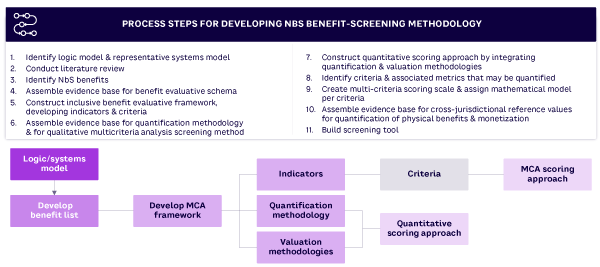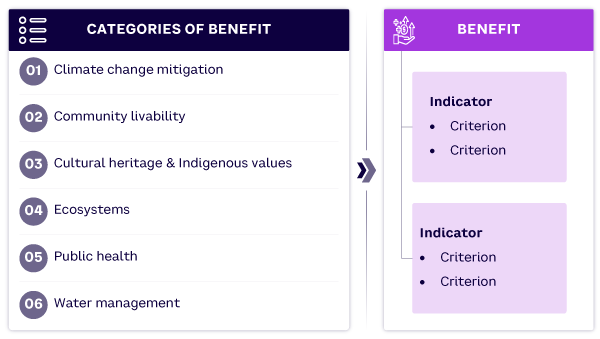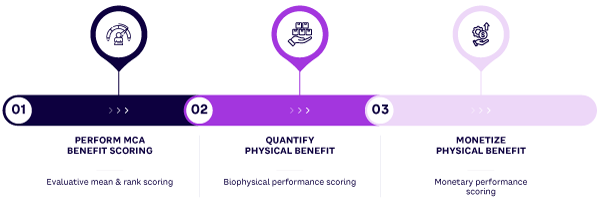Current methodologies and tools for understanding the benefits we receive from nature-based solutions (NbS) tend to be overly simple or overly complex. Sometimes, benefits are evaluated at an extremely high level based primarily on the evaluator’s knowledge and experience. Other times, companies perform cost-benefit analyses that require applying highly detailed scientific and economic data to expensive models.
At both the screening and project levels, initiators may not be able to bear such expenses, and predominantly subjective determinations may lead to undervaluation, lack of transparency, and/or unintended negative consequences to ecologies and societies. This may contribute to underinvestment in NbS due to fear of failure and absence of quantified benefits from proposed or implemented interventions. In other cases, guidelines, instructions, and case studies for the valuation of specific solutions and scenarios are documented, but no method or tool for combining qualitative and quantitative evaluations is provided, so there are gaps in capturing realized benefits across natural, climate, and social systems.
Simplistic evaluations of NbS can obscure the range of both environmental and social opportunities they offer. A holistic approach is needed to tackle the problems of protecting and restoring biodiversity, mitigating and adapting to climate change, and supporting human well-being.
Screening NbS for their potential to deliver multiple benefits to nature and societies can address the challenges we face by integrating qualitative and quantitative measures and evidence. This Advisor proposes a benefit-screening approach for evaluating and documenting the holistic value and impact potential of NbS that can be used in decision-making. Our methodology was developed by combining best practices and guidelines in NbS benefit-performance development indicators with ecosystem services and accounting.
We used a process-based approach to achieve integration, first constructing a representative model for the interaction of Earth systems (nature and biosphere) with societal systems that support human well-being. For the purposes of this Advisor, the model takes the form of a framework for multi-criteria analysis (MCA). After the MCA framework was constructed, we developed quantitative and qualitative screening and scoring approaches. Our process is shown in Figure 1.

Our proposed framework includes indicators and criteria associated with six categories of benefit. The benefit categories, indicators, and criteria are based on a survey of literature performed in accordance with the process steps in Figure 1 and are organized in a hierarchical evaluative schema (see Figure 2).

These categories function as the benefits list and are documented in an MCA framework. The detail associated with the assessment of these benefits provides transparency during the qualitative scoring process by clearly outlining the considerations and reasoning involved.
Once the MCA framework is developed, quantitative and qualitative screening and scoring methodologies can be constructed. For the benefit-screening approach proposed here, benefit quantification includes the two primary steps shown in Figure 3. The qualitative screening and scoring methodology applies a five-point scoring scale and impact-estimation model at the criterion level to the MCA framework.

Physical benefits are quantified by applying ecosystem services accounting principles to identify the resource units associated with a benefit and the resource-unit inputs relevant for benefit evaluation. The individual inputs are then aggregated to calculate the total measured benefit. Once the total measured benefit is calculated, it can be monetized using methods like direct market valuation, contingent valuation, or benefit transfer.
These calculations often rely on reference values from specific case studies or regions, meaning that the resulting values could have limited applicability. Therefore, when using generalized reference values, the outputs should be considered suitable for preliminary decision-making. If the methodology used specific reference values from selected geographies, the accuracy and precision of the outputs would improve, making them more relevant to the specific area.
The full-benefit-screening process includes MCA benefit scoring, quantifying physical benefits, and monetizing these quantified benefits. The outputs generated are inclusive of performance scores in all three steps, as shown in Figure 4. Combining the comprehensive scoring output with a discrete quantification of physical benefit and monetization outputs provides a more transparent statement of holistic benefit. As the physical quantification process step requires technical input for some indicators, there may be gaps in data due to information limits.

In this scenario, the MCA evaluation provides the basis for evaluation and scoring, so all indicators are considered, despite potential data and information gaps. In addition, reporting the biophysical scores separately from the monetary scores provides transparency in the quantification process, highlighting that the benefits extend beyond financial aspects to include natural systems and human well-being.
[For more from the authors on this topic, see: “Understanding the Value of Nature-Based Solutions Through the Lens of Benefit.”]





